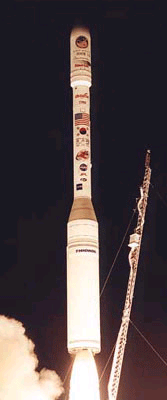Taurus (rocket)
Taurus is a four-stage launch vehicle, developed by Orbital Sciences Corporation, which uses the same Orion solid motor combination as its smaller cousin, the Pegasus, stacked on top of a larger Castor 120 solid motor. First flown in 1994, the Taurus stands 27 meters tall, weighs 69,000–101,000 kilograms at ignition, and is easily transported and launched. It was designed to extend Orbital Sciences's ability to launch small and Med-Lite satellites.
Four variants of the Taurus launch vehicle exist. The smallest, known as the ARPA Taurus, uses a Peace Keeper first stage instead of a Castor 120 motor. The standard Taurus uses a Castor 120 first stage and a slightly larger Orion 50S-G second stage. The Taurus XL uses the Pegasus XL rocket motors and is considered a development stage launch vehicle. The largest Taurus variant, the Taurus XLS, is a study phase vehicle that adds two Castor IVB solid rocket boosters to the Taurus XL to increase payload capacity by 40% over the standard Taurus. For all Taurus configurations, satellite delivery to a geostationary transfer orbit can be achieved with the addition of a Star 37FM perigee kick motor.
Five consecutive launch successes for Taurus, from 1994 through 2000, were followed by a failure on 21 September 2001, in which the OrbView-4 and QuikTOMS satellites were lost.
 |
| launch of a Taurus 2110.
|


